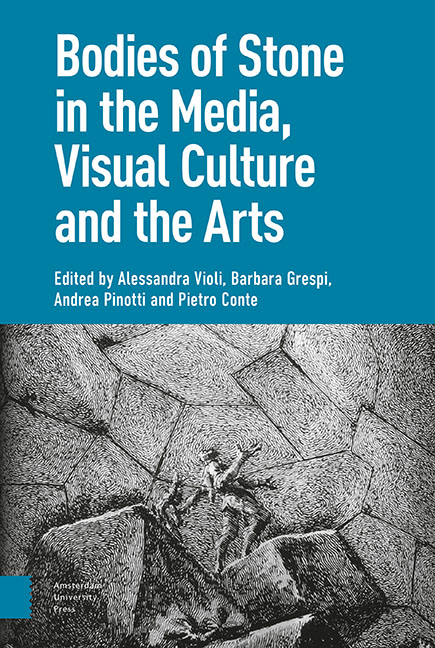Book contents
- Frontmatter
- Contents
- Introduction: Learning from Stone
- I Statue: The Imaginary of Uncertain Petrification
- 1 Theatre and Memory: The Body-as-Statue in Early Modern Culture
- 2 Translated Bodies: A ‘Cartographic’ Approach
- 3 Pantomime in Stone: Performance of the Pose and Animal Camouflage
- 4 Animated Statues and Petrified Bodies: A Journey Inside Fantasy Cinema
- 5 The Ephemeral Cathedral: Bodies of Stone and Configurations of Film
- II Matter: Size, Hardness, Duration
- 1 Bodies That Matter: Miniaturisation and the Origin(s) of ‘Art’
- 2 Brancusi’s ‘Sculpture for the Blind’
- 3 Cinema, Phenomenology and Hyperrealism
- 4 Ephemeral Bodies: The ‘Candles’ of Urs Fischer
- 5 The Celluloid and the Death Mask: Bazin’s and Eisenstein’s Image Anthropology
- III Corpse: Fossils, Auto-Icons, Revenants
- 1 Funeral Eulogy: Post-Mortem Figures and Redeemed Bodies, in Images
- 2 On Jack Torrance As a Fossil Form
- 3 Technical Images and the Transformation of Matter in Eighteenth-Century Tuscany
- 4 Glass, Mixed Media, Stone: The Bodily Stuffs of Suspended Animation
- 5 Bodies’ Strange Stories: Les Revenants and The Leftovers
- IV Monument: Embodying and Grafting
- 1 The Impassibly Fleshly, the Statue of the Impossible
- 2 Frozen into Allegory: Cleopatra’s Cultural Survival
- 3 The Orphan Image
- 4 The Well-Tempered Memorial: Abstraction, Anthropomorphism, Embodiment
- 5 Monuments of the Heart: Living Tombs and Organic Memories in Contemporary Culture
- Index
2 - On Jack Torrance As a Fossil Form
Published online by Cambridge University Press: 20 November 2020
- Frontmatter
- Contents
- Introduction: Learning from Stone
- I Statue: The Imaginary of Uncertain Petrification
- 1 Theatre and Memory: The Body-as-Statue in Early Modern Culture
- 2 Translated Bodies: A ‘Cartographic’ Approach
- 3 Pantomime in Stone: Performance of the Pose and Animal Camouflage
- 4 Animated Statues and Petrified Bodies: A Journey Inside Fantasy Cinema
- 5 The Ephemeral Cathedral: Bodies of Stone and Configurations of Film
- II Matter: Size, Hardness, Duration
- 1 Bodies That Matter: Miniaturisation and the Origin(s) of ‘Art’
- 2 Brancusi’s ‘Sculpture for the Blind’
- 3 Cinema, Phenomenology and Hyperrealism
- 4 Ephemeral Bodies: The ‘Candles’ of Urs Fischer
- 5 The Celluloid and the Death Mask: Bazin’s and Eisenstein’s Image Anthropology
- III Corpse: Fossils, Auto-Icons, Revenants
- 1 Funeral Eulogy: Post-Mortem Figures and Redeemed Bodies, in Images
- 2 On Jack Torrance As a Fossil Form
- 3 Technical Images and the Transformation of Matter in Eighteenth-Century Tuscany
- 4 Glass, Mixed Media, Stone: The Bodily Stuffs of Suspended Animation
- 5 Bodies’ Strange Stories: Les Revenants and The Leftovers
- IV Monument: Embodying and Grafting
- 1 The Impassibly Fleshly, the Statue of the Impossible
- 2 Frozen into Allegory: Cleopatra’s Cultural Survival
- 3 The Orphan Image
- 4 The Well-Tempered Memorial: Abstraction, Anthropomorphism, Embodiment
- 5 Monuments of the Heart: Living Tombs and Organic Memories in Contemporary Culture
- Index
Summary
Abstract
The essay starts with the photograph that reveals the mystery of Stanley Kubrick's The Shining(1980) to introduce the notion of a fossil as a mineral compound that continues to evolve into something biologically distinct from the cadaver that provided its origin. The fossil represents a form of survival in stone, a material within which the dead body can continue to decay and so, in a certain sense, to live on. Considered to be a state of suspended animation, the fossil holds a particular attraction for the cinema, as we see in the character of Jack Torrance, a paradoxical figure who takes on a clear identity if we recognise him as a fossil—and more precisely a ‘living fossil’.
Keywords: Fossil; fossil form ; anachronism; living fossil
We may begin by specifying the topic of the upcoming pages, namely a peculiar relation between the human body—as has been fashioned and hence conceived by cinema—and the fossil, where this latter is taken as a natural form that lends itself, by way of a conceptual reinterpretation, to throwing light on the creation of certain filmic forms and, in the case in hand, of the elaboration of the character of Jack Torrance in Stanley Kubrick's 1980 film The Shining.
From the fossil to the fossil form
A first move towards constructing this hypothesis about fossil forms is a distinction between two types of natural fossils: fossil traces and fossilised organisms. The former present themselves, so to say, as mere imprints that have become permanent through the process of fossilisation, as in the case of the footprints preserved in volcanic ash for just under four million years at Laetoli in Tanzania. By contrast, the fossilised organism is made up of the remains, either complete or more often fragmentary, of an ancient organism that was conserved after its death by complex processes that involved a greater or lesser change in its very substance through exchanges with its geological or ecological surroundings. Thus, for instance, we have the ammonite in a sedimentary bed, the insect trapped in amber, but also the mammoth frozen in Siberian ice (this last case representing less change of substance than the others).
- Type
- Chapter
- Information
- Bodies of Stone in the Media, Visual Culture and the Arts , pp. 231 - 242Publisher: Amsterdam University PressPrint publication year: 2020



